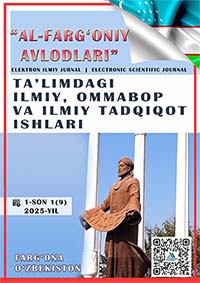HYBRID GENETIC-ANT ALGORITHM BASED ON THE DJJKSTRA METHOD FOR CONSTRUCTING AN OPTIMAL ROUTE FOR A FLIGHT MISSION OF A UAV WITH A COMPLEX TRAJECTORY
Keywords:
Keywords: Dijkstra's algorithm, genetic algorithm, ant colony algorithm, precision farming, optimal route, flight planning, agrodrones.Abstract
Abstract. The article presents an approach to constructing an optimal flight mission for unmanned aerial vehicles (UAVs) intended for use in precision agriculture. The main focus is on the problem of route planning taking into account a complex trajectory and frequent course changes typical for spot processing of agricultural land. The Dijkstra algorithm is used as a basic method, which ensures finding the shortest path between objects. To improve the efficiency of routing, hybridization with genetic and ant algorithms is proposed, which allows adapting to changing conditions and complex field topology.
References
Мохаммад Н., Воронова Л.И., Воронов В.И. Разработка имитационной модели использования роя беспилотных летательных аппаратов в сельском хозяйстве. Наукоемкие технологии в космических исследованиях Земли. 2022; 14(3): 55-61.
Хорт Д.О., Личман Г.И., Филиппов P.A., Беленков А.И. Применение беспилотных летательных аппаратов (дронов) в точном земледелии. Фермер. Поволжье. 2016; 7: 34-37.
Смирнов И.Г., Марченко Л.А., Личман Г.И., Мочкова Т.В., Спиридонов А.Ю. Беспилотные летательные аппараты для внесения пестицидов и удобрений в системе точного земледелия. Сельскохозяйственные машины и технологии. 2017; 3: 10-16. DOI:10.22314/2073-7599-2017-3-10-16
Марченко Л.А., Артюшин А.А., Смирнов И.Г., Мочкова Т.В., Спиридонов А.Ю., Курбанов Р.К. Технология внесения пестицидов и удобрений беспилотными летательными аппаратами в цифровом сельском хозяйстве. Сельскохозяйственные машины и технологии. 2019;13(5):38-45. https://doi.org/10.22314/2073-7599-2019-13-5-38-45
Кайсина И.А.. "МОДЕЛИРОВАНИЕ ПОЛЕЗНОЙ ПРОПУСКНОЙ СПОСОБНОСТИ СЕТИ БПЛА ПРИ МУЛЬТИПОТОКОВОЙ ПЕРЕДАЧЕ" Труды учебных заведений связи, vol. 6, no. 1, 2020, pp. 100-108.
Дорохов Алексей Семенович, Старостин Иван Александрович, Ещин Александр Вадимович, and Курбанов Рашид Курбанович. "ТЕХНИЧЕСКИЕ СРЕДСТВА ДЛЯ ХИМИЧЕСКОЙ ЗАЩИТЫ РАСТЕНИЙ: СОСТОЯНИЕ И ПЕРСПЕКТИВЫ РАЗВИТИЯ" Агроинженерия, vol. 24, no. 3, 2022, pp. 12-18.
Спиридонов, А. Ю. Обоснование параметров беспилотного летательного аппарата для дифференцированного внесения трихограммы / А. Ю. Спиридонов, Р. К. Курбанов // Вестник ВИЭСХ. – 2018. – № 4(33). – С. 101-106. – EDN YTHPFR.
Cao, G., Zhang, Q., Chen, C., Zhang, M., Zhang, J., Huang, Y. (2019). Scheduling model of UAV plant protection team based on multi-objective optimization. Trans. Chin. Soc Agric. Mach. 50 (11), 92–101. doi: 10.6041/j.issn.1000-1298.2019.11.010
Carlton, J. B. (1999). Technique to reduce chemical usage and concomitant drift from aerial sprays: U. s. Patent 5, 975, 425, pp 08–15.
Chen, S., Lan, Y., Bradley, K. F., Jiyu, L. I., Aimin, L. I. U., Yuedong, M. A. O. (2017a). Effect of wind field below rotor on distribution of aerial spraying droplet deposition by using multi-rotor UAV. Trans. Chin. Soc Agric. Mach. 48 (8), 105–113. doi: 10.6041/j.issn.1000-1298.2017.08.011
Chen, S., Lan, Y., Li, J., Xu, X., Wang, Z., Peng, B. (2017b). Evaluation and test of effective spraying width of aerial spraying on plant protection UAV. Trans. Chin. Soc Agric. Eng. 33 (7), 82–0. doi: 10.11975/j.issn.1002-6819.2017.07.011
Feng, Y., Yang, Q. (2014). Key research fields and basic directions of Chinese rural-land comprehensive consolidation in transitional period. Trans. Chin. Soc Agric. Eng. 30 (1), 175–182. doi: 10.3969/j.issn.1002-6819.2014.01.023
Kirk, I. W. (2003). “Electrostatic coalescence for aerial spray drift mitigation,” in National cotton council of America (Nashville: Beltwide Cotton Conferences), 189–191.
Kirk, I. W., Hoffmann, W. C., Carlton, J. B. (2001). Aerial electrostatic spray system performance. Trans. ASAE 44 (5), 1089–1092. doi: 10.13031/2013.6431
Lan, Y., Thomson, S. J., Huang, Y., Hoffmann, W. C., Zhang, H. (2010). Current status and future directions of precision aerial application for site-specific crop management in the u. s. a. Comput. Electron. Agric. 74 (1), 34–38. doi: 10.1016/j.compag.2010.07.001
Lou, S. Y., Xue, X. Y., Gu, W., Cui, L. F., Xiao, H. T., Tian, Z. (2017). Current status and trends of agricultural plant protection unmanned aerial vehicle. J. Agric. Mech. Res. 39 (12), 1–6. doi: 10.13427/j.cnki.njyi.2017.12.001
A.-Q. Alzalloum, Application of Shortest Path Algorithms to Find Paths of Minimum Radiation Dose, Ph.D. dissertation, Univ. Illinois at Urbana-Champaign, 2010.
Q.-Y. Pei, L.-J. Hao, C.-H. Chen, X.-L. Zheng, and T. He, "Minimum collective dose based optimal evacuation path-planning method under nuclear accidents," Ann. Nucl. Energy, vol. 147, p. 107644, 2020.
P. E. Hart, N. J. Nilsson, and B. Raphael, "A formal basis for the heuristic determination of minimum cost paths," IEEE Trans. Syst. Sci. Cybern., vol. 4, pp. 100–107, 1968.
C. Chen, J. Cai, Z. Wang, F. Chen, and W. Yi, "An improved A* algorithm for searching the minimum dose path in nuclear facilities," Prog. Nucl. Energy, vol. 126, p. 103394, 2020.
H. Miao, G. Zhang, P. Yu, C. Shi, and J. Zheng, "Dynamic dose-based emergency evacuation model for enhancing nuclear power plant emergency response strategies," Energies, vol. 16, p. 6338, 2023.
M. Qiu, H. Zhang, and H. Zhou, "Path planning for nuclear radiation environments based on an improved artificial potential field A* algorithm," *J. Radiat. Res. Radiat. Process.*, vol. 40, pp. 53–61, 2022.
Y.-k. Liu, M.-k. Li, C.-l. Xie, M.-j. Peng, S.-y. Wang, N. Chao, and Z.-k. Liu, "Minimum dose method for walking-path planning of nuclear facilities," *Ann. Nucl. Energy*, vol. 83, pp. 161–171, 2015.
Y.-k. Liu, M.-k. Li, M.-j. Peng, C.-l. Xie, C.-q. Yuan, S.-y. Wang, and N. Chao, "Walking path-planning method for multiple radiation areas," *Ann. Nucl. Energy*, vol. 94, pp. 808–813, 2016.
C. W. Ahn and R. S. Ramakrishna, "A genetic algorithm for shortest path routing problem and the sizing of populations," *IEEE Trans. Evol. Comput.*, vol. 6, pp. 566–579, 2002.
A. W. Mohemmed, N. C. Sahoo, and T. K. Geok, "Solving shortest path problem using particle swarm optimization," *Appl. Soft Comput.*, vol. 8, pp. 1643–1653, 2008.
Y.-k. Liu, M.-k. Li, C.-l. Xie, M.-j. Peng, and F. Xie, "Path-planning research in radioactive environment based on particle swarm algorithm," *Prog. Nucl. Energy*, vol. 74, pp. 184–192, 2014.
Z. Wang and J. Cai, "The path-planning in radioactive environment of nuclear facilities using an improved particle swarm optimization algorithm," *Nucl. Eng. Des.*, vol. 326, pp. 79–86, 2018.
Additional Files
Published
How to Cite
License
Copyright (c) 2025 Н.С. Маматов, Д.Т. Мухамедиева, Д.И. Ковалев

This work is licensed under a Creative Commons Attribution 4.0 International License.












